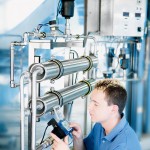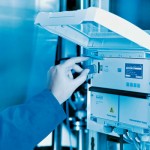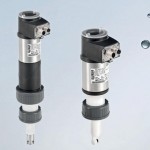Proper process monitoring and control of critical parameters such as pH, ORP, conductivity, flow, temperature and differential pressure can guard membrane elements in reverse osmosis applications against scaling, fouling or chemical attack. With its multifunctional analytical instruments and a broad range of switches, transmitters and valves, Bürkert provides intelligent technology that protects membranes, enhances process efficiency and lowers operating and chemical costs.
To produce high-purity water, the fluid has to undergo a complicated purification process. The heart of this process is the reverse osmosis plant. Pre-treatment is essential to ensure all oxidising agents, organic or inorganic fouling contaminants and scale compounds are eliminated or at least minimised. Scaling, fouling and oxidation are the natural enemies of reverse osmosis (RO) systems in water processing units. If early warnings are ignored, the membrane may be damaged beyond the point where chemical cleaning can restore the system back to its original operating efficiency. Preventing excessive build-up of contaminants can be accomplished with proper instrumentation and control processes in place. Integrated solutions from Bürkert Fluid Control Systems comprise pneumatic or solenoid isolation valves, flow measurement devices, conductivity, pH and ORP transmitters and controllers as well as complete control system solutions.
If left unchecked, chlorine or other oxidising chemicals could physically attack the very thin polyamide membrane, creating points of leakage for dissolved salts to pass through. This type of damage is irreparable. It is therefore quite common to install an ORP (Oxidation Reduction Potential) meter upstream of an RO plant with an integrated alarm point. The perfect pH for RO membranes in a slightly acidic environment is between 5 and 6. This pH prevents the formation of carbonates as well as hydrolysis effects for certain cellulose acetate membranes. pH transmitters and controllers like Bürkert’s model type 8202 measure and transmit the pH and temperature of the incoming water. Other compact field instruments, like the 8205 pH unit, transmit and control pH according to a predetermined internal setpoint. A deviation from the set values automatically triggers a digital dosing pump that adds acid to the RO feed water. This prevents the formation and precipitation of calcium carbonate crystals on an RO membrane, which could result in reduced recovery as well as lower water quality.
Monitoring conductivity
The most important and most commonly monitored system parameter in an RO plant is conductivity. Feed water conductivity is one of the key factors influencing the plant recovery rate or flux of the membrane used in reverse osmosis systems. The higher the conductivity, the higher the osmotic pressure. A higher osmotic pressure results in a less efficient system at the same given pressure and temperature. It is important to be able to identify changes in product water production due to feed conductivity fluctuations. This evaluation helps rule out a more serious problem such as scaling or fouling. The percentage difference between the feed water conductivity and the permeate is referred to as the “% reject”. This difference tells the operator which percentage of salts has been rejected and helps assess the overall system health. It is common to reject 95 % to 98 % of all the salts in a reverse osmosis system for brackish water. In larger systems, where it is vital to normalise the permeate flow, conductivity is generally monitored not only on the feed and permeate lines but also on the concentrate line. Normalising permeate flow is done to compare system performance at start-up to that at a later date. Changes in plant pressure, temperature and conductivity have to be normalised to determine changes in plant performance accurately.
Temperature and pressure
Membrane flux, or the amount of water that permeates an RO membrane, is also directly influenced by temperature. The higher the temperature, the higher the flux rate at a given conductivity and pressure. It is considered quite standard to expect a 1.5 % increase or decrease in system performance for every 1 °C change in water temperature. At the same time, reverse osmosis performance depends directly on feed pressure. Comparative measurements and trending of feed, permeate, concentrate and inter-stage pressures ensure that the system is working at full capacity. Monitoring pressure differentials additionally helps the operator identify potential first-stage fouling or second-stage scaling problems. The two most popular ways to control RO system pressure are with a control valve on the concentrate line or using a variable speed, high pressure pump.
The percentage recovery of the RO system is likewise a key parameter for assessing system health and is measurd with a Bürkert magnetic or paddle flow meter. It is determined by calculating the percentage of the total feed flow that becomes product water or permeate. An increase or decrease in this value at the same given conductivity, temperature and pressure could be an early indicator of a chemically attacked, scaled or fouled membrane.
Efficient control system
Individual measurements alone do not increase the cost efficiency of the process. Only an effective process control system that groups and regulates all parameters such as flow rate, temperature, pH/ORP, conductivity and pressure can produce real advantages. A multifunctional control system like the multi-parameter mxControl 8620 controller automates the control of process variables in water treatment systems. In some cases, this controller is able to reduce control and measuring instrumentation costs by almost half. Simple monitoring and control functions, as well as the gathering of data, are integrated in a compact and easily configurable control unit with a display. An example of percentage recovery is the relationship between total feed flow and product or permeate flow.
A typical brackish water system can operate at 75 % bis 85 %. If this value decreases during the course of the process, the control unit monitors and logs every single parameter that is necessary for fault analysis. The initial focus is on pH, then on conductivity, temperature and pressure. If all parameters are within the control range, but the performance of the membranes still falls short of the nominal value, this could be due to a scaling or fouling event. This can be quickly differentiated with the help of appropriate monitoring points. If a higher pressure drop occurs at the first stage, the reason is most often due to colloidal or bio-fouling. An increased pressure drop at the second stage generally indicates an elevated mineral level or the occurrence of scaling. A self-contained multifunctional unit can be used to track and log multiple process points precisely and simultaneously.
Through its parameterisation of a series of control values via an SD card slot and a USB or Ethernet port, the control is es- pecially adapted for process monitoring and chemical control systems. The intuitive PC software enables the controller to be adjusted to a wide range of process requirements and applications. Data such as the flow rate, pressure, pH/ORP, conductivity, O2, Cl2, water level and temperature can be displayed, controlled, recorded and transmitted. The multi-parameter controller can be connected to up to six analogue and eight digital inputs (four of which can be flow), such as conductivity, pH/ORP, temperature, pressure, etc. It features up to four analogue and nine digital outputs for a multitude of conditions from simply retransmitting a process value to pulse or frequency-controlled dosing of a metering pump. The controller can additionally transmit analogue outputs from one of the eight PID control blocks. The controller is capable of fully responding to the constantly changing requirements of general process control parameters. Such elaborate process controls only make sense for more complex RO systems, while a chemical pump in conjunction with a compact, pipe-mounted, dynamic pH transmitter/controller like the 8205 is sufficient for simpler configurations where only the feed water pH needs to be lowered.
The combination of element transmitters that transmits process values and temperature can also perform simple on/off control or alarm functions to reduce overall system costs. These field mounted devices moreover enable quick refitting and upgrading of simple RO processes. Apart from measuring the conductivity, pH and ORP, the element range of transmitters has options that enable transmission and on/off control of temperature. The transmitters are programmed via a removable module that can remain with the unit if local display is required. If the values deviate from the originally programmed set value, the transmitter triggers a transistor switch that opens or closes a valve or starts a pump, allowing the influx of fresh water or chemicals to regulate the pH, conductivity, temperature or ORP.
Online-Info www.cpp-net.com/2209455
Share:









